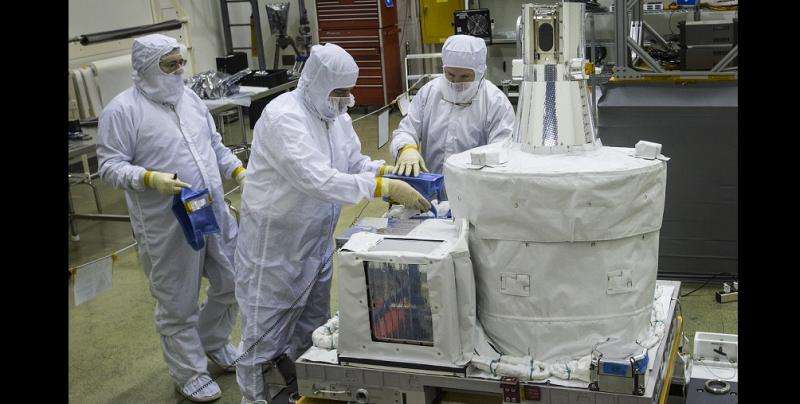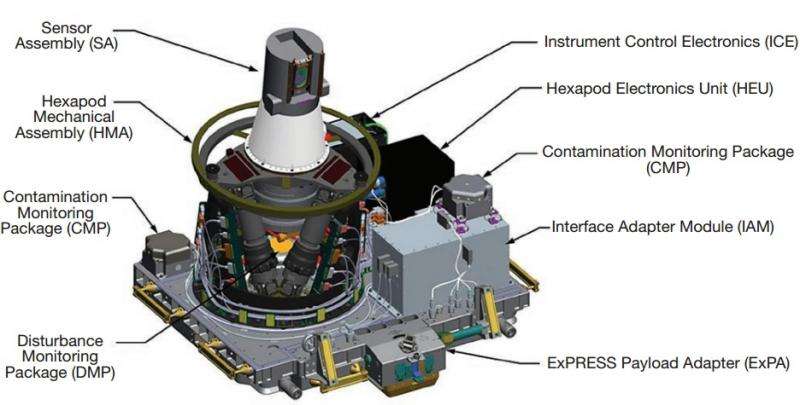SAGE III to provide highly accurate measurements of atmospheric gases

The International Space Station (ISS) will soon get an important tool capable of conducting highly accurate measurements of aerosols and gaseous constituents in the stratosphere and troposphere. The Stratospheric Aerosol and Gas Experiment III (SAGE III) will study ozone, aerosols, water vapor, and other atmospheric gases to better understand the effects of natural and human-induced changes on the global environment.
SAGE III was initially planned for launch to ISS aboard the SpaceX Dragon cargo craft in November 2016 atop a Falcon 9 launcher. The mission, designated CRS-10, was to be lifted off from from Cape Canaveral Air Force Station's (CCAFS) Space Launch Complex 40. However, it was postponed several times and is currently targeted for launch on Feb. 8, 2017 from the Launch Complex 39A. The delays were forced by a pending investigation of the Sept. 1 explosion at the launch site when a Falcon 9 rocket was destroyed during a pre-launch static fire test.
The SAGE III instrument was delivered from NASA's Langley Research Center to NASA Kennedy Space Center (KSC) in November 2015 and is now completely ready for launch.
"Final powered testing was completed at the KSC Space Station Processing Facility during the past year, and in December 2016, the instrument payload and the Nadir Viewing Platform were handed over to SpaceX for installation into the Dragon Trunk of the Falcon 9 rocket. The integrated trunk is now awaiting launch," Marilee M. Roell, SAGE III Science Manager at NASA's Langley Research Center told SpaceFlight Insider.
Roell added that all technical work is complete except for a few remove-before-flight items. Although a couple of pre-launch reviews are planned, all preliminary mission operations activities have been already completed.
"The team is well rehearsed and we are ready to support the mission after launch," Roell said.
After arrival at ISS, SAGE III will be mounted externally on the station on the Expedite the Processing of Experiments to Space Station (ExPRESS) Pallet Adapter (ExPA) to the Express Logistic Carrier (ELC). The instrument will orbit between 239 and 257 miles (385 and 415 kilometers) above Earth's surface at a 51.6-degree inclination with nearly a three-day repeat cycle. The station's orbit is expected to help maximize the scientific value of SAGE III observations while proving that atmospheric science instruments do have a place on the orbital laboratory.
To fulfill its scientific goals, SAGE III is equipped with a set of tools with a total mass of about 1,162 lbs. (527 kilograms). Its most important payload is the Sensor Assembly (SA) instrument—a grating spectrometer that measures ultraviolet and visible light and has a two-axis pointing system. SA contains the Charge Coupled Device (CCD) array detector that enhances measurement capability and may allow for new experimental data products like methane, bromine monoxide, and iodine monoxide, as well as measure larger aerosols.

SAGE III is also fitted with the Interface Adapter Module (IAM), the Disturbance Monitoring Package (DMP), the Hexapod Pointing System (Hexapod Electronics Unit and Hexapod Mechanical Assembly), and the Instrument Control Electronics box. IAM is characterized as the "brain" of the instrument payload, providing power and computing to the payload and acting as the interface between the instrument and the station. DMP is a miniature inertial measurement unit that will measure all of the small motions from the ISS, while the Hexapod Pointing System will act as the "legs" of the payload, which keep the instrument level in orbit.
The main scientific objective of the SAGE III mission will be obtaining high quality, global measurements of key components of Earth's atmosphere. In particular, the instrument will assess the state of recovery in the distribution of ozone and will re-establish the aerosol measurements needed by both climate and ozone models. The mission is expected to gain further insight into key processes contributing to ozone and aerosol variability.
"Our view from the space station will give us a new perspective of atmospheric composition. Data from SAGE III, coupled with model results, will allow scientists to monitor the health of the ozone layer and track the recovery of stratospheric ozone since ratification of the Montreal Protocol. By the 2020s—in most areas—models predict that ozone will have recovered about half of the amount lost from the pre-1980 levels. SAGE III will be valuable in assessing the performance of the Ozone Mapping and Profiler Suite flying on the Suomi National Polar-orbiting Partnership satellite," Roell said.
Data from SAGE III will also help to reinstitute aerosol measurements crucial for more-accurate long-term climate and ozone models. Moreover, if there are any new changes to the ozone layer, these data will help the scientific community identify the cause and assess the impact of the changes.
Understanding the stratospheric ozone changes is crucial to determine whether the recovery of the ozone layer is progressing as expected since the Montreal Protocol was enacted.
"We expect to see some recovery, based on model data, in the amount of stratospheric ozone since the 1990s. We'll also be looking to see if there are any new changes occurring in the stratosphere," Roell noted.
The instrument that will be installed on the ISS is the second SAGE III sent into space. The first SAGE III was launched on the Russian Meteor-3M spacecraft in December 2001. SAGE is one of NASA Langley's longest running Earth science missions. The idea for the instrument, beginning in the 1970s with the Stratospheric Aerosol Measurement (SAM) instrument, was developed and tested at Langley.
"SAM, as well as SAM II, SAGE, SAGE II, SAGE III Meteor-3M and now SAGE III/ISS have all been led by Langley. This latest project also included the Nadir Viewing Platform to point SAGE in the right direction, as well as other new hardware and software, all of which was designed, built, integrated, and tested at Langley," Roell said.
SAGE III on ISS will be operated from the Flight Mission Support Center at Langley. Ball Aerospace & Technologies Corp. built the SAGE III/ISS instrument in Boulder, Colorado, and the European Space Agency and Thales Alenia Space provided a hexapod to keep the instrument pointing in the right direction as the ISS maneuvers in space.
Provided by Astrowatch.net





















